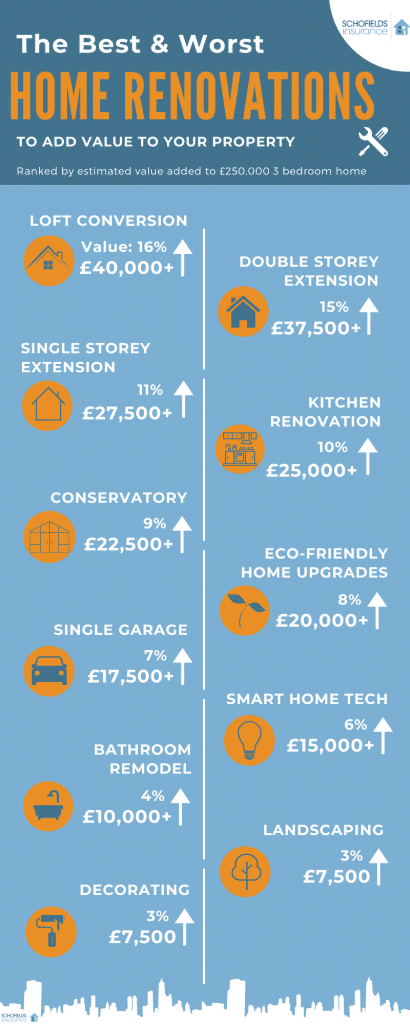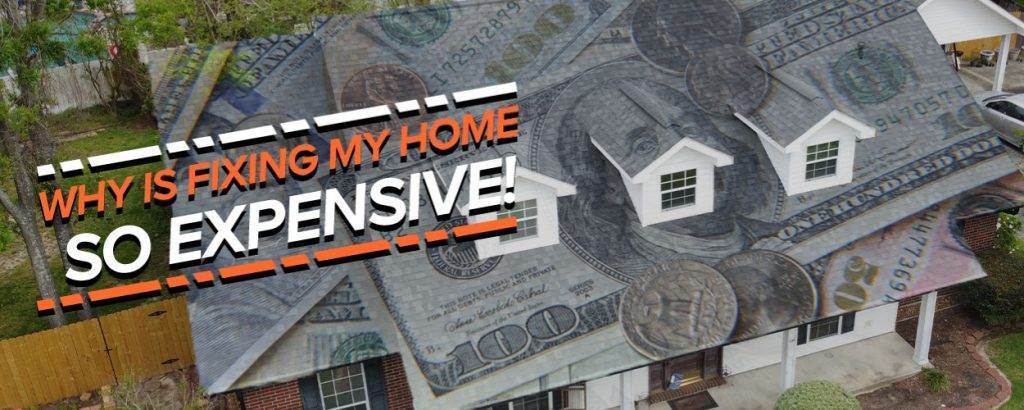So you decided it’s finally time to give your home a much-needed makeover. You’ve been envisioning the beautifully renovated kitchen and the luxurious bathroom for years, but as soon as you started getting quotes from contractors, reality hit you like a ton of bricks. The prices seem astronomical, leaving you wondering, “Why is home improvement so expensive?” In this article, we’ll explore the various factors that contribute to the high costs of home improvement projects, shedding light on the reasons behind those jaw-dropping price tags. Home improvement projects can often come with hefty price tags, leaving many homeowners wondering why the costs are so high. Several factors contribute to the high expenses associated with home improvement, ranging from limited competition to fluctuating raw material costs. In this article, we will explore the various reasons why home improvement can be costly and shed light on the factors that contribute to these expenses.

This image is property of www.schofields.ltd.uk.
Lack of Competition
Limited number of suppliers
One of the reasons why home improvement can be expensive is the limited number of suppliers available in the market. With fewer suppliers, there is less competition, which can drive up prices. This scarcity of suppliers can lead to a lack of options for consumers, increasing the chances of being stuck with higher costs for materials.
Fewer contractors in the market
Similarly, the number of contractors in the market also plays a role in the cost of home improvement projects. When there are fewer contractors available, the demand for their services increases. This heightened demand allows contractors to charge higher rates for their work, as homeowners are willing to pay a premium to secure their services. The lack of competition in the contractor market further contributes to the overall cost of home improvement.
High demand for construction materials
High demand for construction materials is yet another factor that drives up home improvement costs. As more homeowners undertake renovation projects, the demand for materials increases, outstripping the supply. This increased demand puts upward pressure on prices, making construction materials more expensive. Additionally, the scarcity of certain materials due to limited production or availability can further escalate the costs of home improvement projects.
Labor Costs
Skilled labor shortage
One of the primary contributors to high home improvement costs is the shortage of skilled labor. With many skilled workers retiring and fewer individuals pursuing careers in the trades, the supply of skilled labor has dwindled. As a result, contractors must pay higher wages to attract experienced workers, passing the increased labor costs onto homeowners. This shortage of skilled labor drives up the prices of home improvement projects.
Higher wages for specialized trades
Specialized trades, such as electricians or plumbers, often command higher wages due to the technical expertise required for their work. Their specialized skills and certifications make them highly sought after, driving up their labor costs. When homeowners require the services of these specialized trades, they can expect to pay a premium for their expertise, contributing to the overall expense of home improvement projects.
Labor-intensive nature of home improvement projects
Home improvement projects are often labor-intensive, requiring significant time and effort from workers. From demolishing structures to installing new features, the manual labor involved in these projects can be strenuous and time-consuming. The labor-intensive nature of home improvement increases the amount of work required, consequently driving up the costs associated with projects.
Permitting and Regulatory Expenses
Fees for building permits
Obtaining the necessary permits for home improvement projects incurs additional expenses. Building permits have associated fees that vary depending on the location and the scope of the project. These fees can quickly add up, further increasing the overall cost of home improvement.
Inspection costs
In addition to building permits, home improvement projects often require inspections to ensure compliance with local building codes and regulations. These inspections come with inspection costs, which homeowners must bear. The expenses associated with inspections serve as additional financial burdens when undertaking home improvement, contributing to the overall price tag.
Code compliance requirements
Adhering to building codes and regulations is crucial for a successful home improvement project. However, meeting these code compliance requirements can involve additional expenses. From modifying existing structures to installing safety features, ensuring code compliance can require additional materials and labor. These extra costs increase the overall price of home improvement projects.
Raw Material Costs
Fluctuating prices of construction materials
The prices of construction materials are subject to frequent fluctuations. Factors such as supply and demand, international trade policies, and inflation can all influence the cost of construction materials. When prices rise, consumers can expect to pay higher prices for materials needed for home improvement projects, further increasing the overall expenses.
Import/export tariffs on certain products
Import and export tariffs imposed on certain construction materials can also impact the cost of home improvement. These tariffs are designed to protect domestic industries and can raise the prices of imported materials. When contractors or homeowners rely on materials subject to import/export tariffs, they must bear the additional costs, making home improvement more expensive.
Increased demand for sustainable materials
With the growing focus on sustainability and environmental consciousness, there has been an increased demand for sustainable materials in home improvement projects. However, sustainable materials often come at a higher price compared to traditional alternatives. The increased demand and limited supply for sustainable materials contribute to their higher costs, making sustainable home improvement projects more expensive.

This image is property of cdn.images.express.co.uk.
Overhead Expenses
Utility bills and insurance costs
In addition to the direct costs of materials and labor, home improvement expenses also include overhead expenses. These overhead expenses encompass utility bills and insurance costs. Contractors often factor in these overhead expenses when pricing their services, passing them onto homeowners. The inclusion of overhead costs further adds to the overall expense of home improvement projects.
Equipment and tool maintenance
Home improvement projects rely heavily on various tools and equipment. Regular maintenance and repairs of these tools and equipment incur costs that are factored into the overall price of projects. Contractors may pass on these maintenance expenses to homeowners through their services, contributing to the increased costs of home improvement.
Office expenses and administrative charges
Behind-the-scenes administrative tasks and office expenses also contribute to the overall cost of home improvement projects. From hiring office staff to managing paperwork and organizing schedules, these administrative tasks incur expenses that are ultimately passed onto homeowners. These additional charges further add to the overall cost of home improvement.
Market Trends
Inflation and rising interest rates
Home improvement costs can be influenced by broader market trends. Factors such as inflation and rising interest rates can impact the cost of materials, labor, and financing options. In times of inflation or when interest rates are high, the overall cost of home improvement projects tend to rise. These market trends make home improvement more expensive for homeowners.
Changing consumer preferences
Consumer preferences and trends can also influence home improvement costs. As consumer demands change, homeowners seek more personalized and customized projects to align with their preferences. Tailoring projects to individual preferences often requires additional materials or specialized services, which come with higher costs. The changing landscape of consumer preferences, therefore, contributes to the increased expenses associated with home improvement.
Homeowners investing in premium upgrades
Another market trend that impacts the cost of home improvement is homeowners’ inclination towards premium upgrades. With the desire for high-end finishes and luxurious features, homeowners are willing to pay more for these premium upgrades. The demand for upscale materials and unique customization options increases the costs of home improvement, making such projects more expensive.

This image is property of images.ctfassets.net.
Hidden or Unforeseen Costs
Structural issues or pre-existing damage
Home improvement projects can uncover hidden or unforeseen costs when structural issues or pre-existing damage is discovered. In the process of renovation, contractors may come across unexpected problems that require additional repairs and expenses. These unforeseen costs contribute to the overall price of home improvement projects, making them more expensive than initially estimated.
Discovering mold or asbestos during renovations
Unearthing mold or asbestos during home improvement projects can significantly impact the overall costs. The discovery of these hazardous materials necessitates specialized removal and remediation services, which can be expensive. The costs associated with addressing mold or asbestos further contribute to the overall expense of home improvement, making it a costly endeavor.
Additional repairs required midway through the project
While undertaking home improvement projects, additional repairs may be required midway through the process. Whether it’s addressing structural issues or fixing faulty wiring, these additional repairs increase the overall costs of the project. Homeowners must be prepared for such unforeseen repairs, as they can significantly impact the budget and make home improvement more expensive.
Seasonal Fluctuations
Higher prices during peak construction seasons
The seasonality of the construction industry can impact the cost of home improvement projects. During peak construction seasons, when contractors are in high demand, they can charge higher prices for their services. This increased demand during specific times of the year causes a surge in labor costs, contributing to the higher expenses of home improvement.
Limited availability of contractors during busy periods
Peak construction seasons also bring about limited availability of contractors. With the high demand for their services, contractors may have limited availability, leading to longer wait times and potentially higher costs for homeowners. The limited availability of contractors during busy periods further adds to the challenges and increased expenses of home improvement projects.
Weather-related challenges impacting project timelines
Weather-related challenges can also impact the cost of home improvement. Adverse weather conditions can cause project delays, resulting in additional labor costs and extended timelines. From rainstorms delaying exterior projects to harsh winter weather impeding progress, these weather-related challenges can increase the overall cost of home improvement projects.

This image is property of cdn.images.express.co.uk.
Specialized Equipment and Tools
Expensive machinery and tools required for specific projects
Certain home improvement projects require specialized equipment and tools that can be costly to purchase or rent. For example, heavy machinery for excavation or high-end power tools for intricate woodworking can come with significant price tags. The need for these specialized equipment and tools adds to the overall expenses of home improvement projects.
Rental costs for specialized equipment
When specialized equipment and tools are not regularly used in a homeowner’s toolbox, renting becomes a cost-effective solution. However, rental costs for specialized equipment can quickly accumulate. Homeowners opting to rent these tools for their projects must factor in the rental costs, contributing to the overall expense of home improvement.
Maintenance and repair expenses for equipment
Owning or renting specialized equipment for home improvement projects entails maintenance and repair expenses. These costs include routine maintenance, occasional repairs, or even replacements of equipment. Contractors often account for these expenses in their pricing, passing them onto homeowners. The added maintenance and repair expenses for equipment further drive up the costs of home improvement.
Customization and Personalization
Tailoring projects to meet individual preferences
Many homeowners seek customization and personalization in their home improvement projects. Whether it’s designing a unique kitchen layout or selecting specific finishes, customization often comes at a higher cost. The need to tailor projects to individual preferences increases the complexity of the work, requiring additional materials or specialized labor. This customization contributes to the higher expenses associated with home improvement.
High-end finishes and luxury features
Homeowners who desire high-end finishes and luxury features in their home improvement projects must be prepared for the higher costs. Premium materials, high-quality appliances, and luxurious fixtures can come at a significant price. Incorporating these high-end finishes and luxury features adds to the overall expense of home improvement, making it a more costly endeavor.
Consultation fees for interior design or architectural services
Seeking consultation or professional guidance from interior designers or architects during home improvement projects incurs additional costs. These design professionals bring expertise and creativity to the table, but their services come at a price. Incorporating consultation fees into the overall budget contributes to the increased expenses of home improvement projects.
In conclusion, home improvement costs are influenced by various factors that drive up prices. Limited competition, labor costs, permitting and regulatory expenses, raw material costs, overhead expenses, market trends, hidden or unforeseen costs, seasonal fluctuations, specialized equipment and tools, and customization and personalization all contribute to the overall expense of home improvement projects. Understanding these factors can help homeowners make informed decisions and better navigate the costs associated with improving their homes.

This image is property of theroofinginsider.pro.
